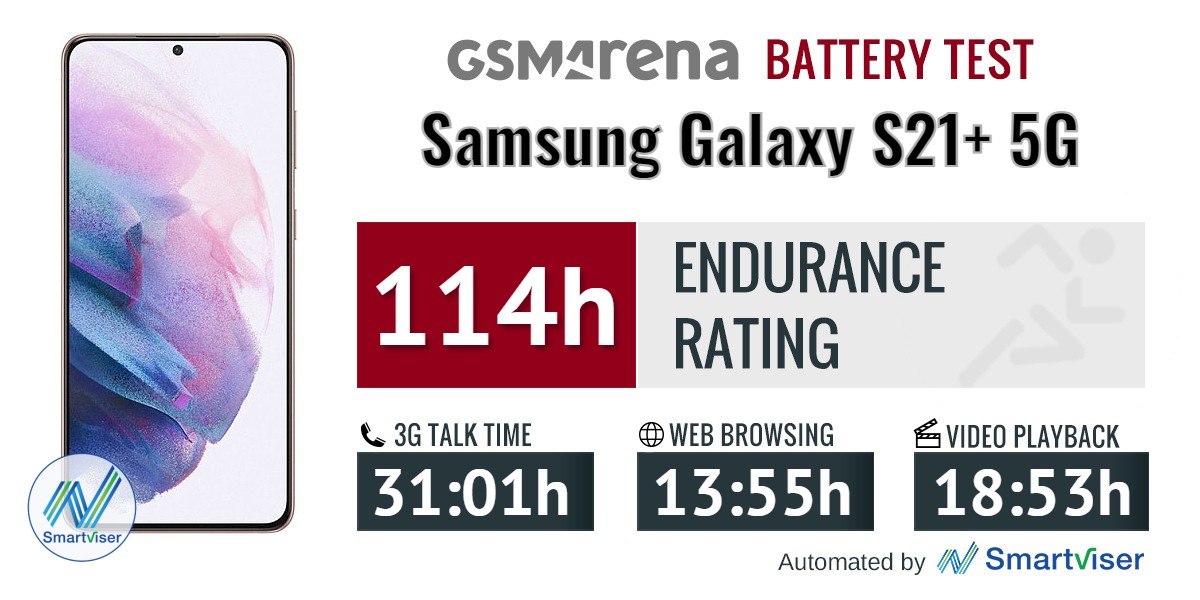Introduction
Almost as big as the Ultra, but not quite as camera-centric. Nearly identical to the vanilla, but with plus-size screen, extra battery and a more premium touch. Yes, we're talking about the middle option in the 2021 Samsung S-series roster, the Galaxy S21+.
Plus stands for 'more of it' and the S21+ has a bigger display - at 6.7 inches in diagonal it's a lot closer to the Ultra's 6.8 inches than it is to the S21 proper's 6.2. Beyond the size, however, it's more vanilla than it is Ultra - the resolution is 1080p and the Adaptive refresh rate handling is the half-there variety, but Adaptive it is nonetheless.
There's 'more of it' when it comes to battery capacity and here, too, Plus aims for the Ultra - at 4,800mAh it's oh so close to the 5,000mAh of the top model. More importantly, perhaps, the middle option is the only one that's gotten an upgrade YoY.
The third area where the Galaxy S21+ differs from the S21 is the build. And here, from the vantage point of the S21+, the choice of plastic for the S21's back makes sense - this way the Plus has one more thing going for it. Maybe.
 A family of Galaxies: S21, S21+, S21 Ultra
A family of Galaxies: S21, S21+, S21 Ultra
We touched upon the differences between the S21 and S21+, two out of three of those quantitative, the other - well, qualitative. Here's a reminder of the other bits that make up the S21+.
Samsung Galaxy S21+ 5G specs at a glance:
- Body: 161.5x75.6x7.8mm, 200g; Glass front (Gorilla Glass Victus), glass back (Gorilla Glass Victus), aluminum frame; IP68 dust/water resistant (up to 1.5m for 30 mins).
- Display: 6.70" Dynamic AMOLED 2X, 120Hz, HDR10+, 1300 nits (peak), 1080x2400px resolution, 20:9 aspect ratio, 394ppi; Always-on display.
- Chipset (International): Exynos 2100: Octa-core (1x2.9 GHz Cortex-X1 & 3x2.80 GHz Cortex-A78 & 4x2.2 GHz Cortex-A55); Mali-G78 MP14.
- Chipset (USA/China): Qualcomm SM8350 Snapdragon 888 (5 nm): Octa-core (1x2.84 GHz Kryo 680 & 3x2.42 GHz Kryo 680 & 4x1.80 GHz Kryo 680; Adreno 660.
- Memory: 128GB 8GB RAM, 256GB 8GB RAM; UFS 3.1.
- OS/Software: Android 11, One UI 3.1.
- Rear camera: Wide (main): 12 MP, f/1.8, 26mm, 1/1.76", 1.8µm, Dual Pixel PDAF, OIS; Ultra wide angle: 12 MP, f/2.2, 13mm, 120˚, 1/2.55" 1.4µm, Super Steady video; Telephoto: 64 MP, f/2.0, 29mm, 1/1.72", 0.8µm, PDAF, OIS, 1.1x optical zoom, 3x hybrid zoom.
- Front camera: 10 MP, f/2.2, 26mm, 1/3.24", 1.22µm, Dual Pixel PDAF.
- Video capture: Rear camera: 8K@24fps, 4K@30/60fps, 1080p@30/60/240fps, 720p@960fps, HDR10+, stereo sound rec., gyro-EIS; Front camera: 4K@30/60fps, 1080p@30fps.
- Battery: 4800mAh; Fast charging 25W, USB Power Delivery 3.0, Fast Qi/PMA wireless charging 15W, Reverse wireless charging 4.5W.
- Misc: Fingerprint reader (under display, ultrasonic); NFC; FM radio (Snapdragon model only; market/operator dependent); Samsung DeX, Samsung Wireless DeX (desktop experience support), Samsung Pay (Visa, MasterCard certified), ANT+, Bixby natural language commands and dictation.
Samsung Galaxy S21+ unboxing
The Galaxy S21+ arrives in the same half-height box as the other high-end Galaxies for 2021 and, likely, from here on. When you don't pack a charger and headphones, there's no point in wasting cardboard, is there?

We're not strictly against the disappearing chargers trend. There are charging stations in the office with, what is that, QuickCharge 3.0 outputs, that we use most of the time and those have been serving us well for several years and will continue to do so. Additionally, between us we've bought an assortment of USB PowerDelivery adapters for personal use and the bulk of us likely fall in that group of people who won't be needing new chargers with their next phone purchase. So there could be actual benefits to this, eventually. Perhaps the way the marketing teams have been sugarcoating the process is what's been most annoying. Anyway, on to the design.
Design
If you've seen the Galaxy S21, you've seen the Galaxy S21+. We have them here in this year's hero colorway called Phantom Violet and they look like they're the same thing, albeit at a slightly different scale.

Samsung's design accent for 2021 is the camera surround which appears to flow out of the frame, with a color to match it too. Several two-tone color combos, ours included, make that frame-camera link more prominent thanks to contrasting hues to the rear panel. Stealthier options are available too, the black-on-black (Phantom Black) approaching the S21 Ultra's vibe.
 Family shot: regular, Plus, and Ultra
Family shot: regular, Plus, and Ultra
Speaking of the Ultra, the S21+ has the same type of back as its all-out stablemate. The Plus has its internals covered by a sheet of Gorilla Glass Victus, treated to a frosted matte finish. It's cold to the touch in a way that the S21 isn't and that difference is what sets the small phone apart from the other two - arguably, in a bad way.
 Galaxy S21+ next to Galaxy S21
Galaxy S21+ next to Galaxy S21
There's a lot of subjectivity in what passes for premium materials on smartphones. We defended the S21's use of plastic - it helps make it lighter and cheaper, so it suits that model perfectly. Meanwhile, a couple of extra grams in the cover of the S21+ we have here can be attributed to the larger battery and go unnoticed in the 200g total. And, well, it's more expensive, so it better not cut corners and use inexpensive materials, right?
We could probably go on rationalizing Samsung's choices, but the fact is that the Plus does feel smoother and more refined than the vanilla. The flipside to this is that it's also more slippery - whether it's the extra weight and bulk or the fact that we had to be particularly careful with this unit, there was a constant feeling of precariousness when handling the S21+. Universal equalizers of the case type will certainly help with both grip and peace of mind, but the bare phone is just slippery and that's that.

Over on the front there's some more Victus. Drop tests, or rather real life will show how durable it is, but it's good to know that the S21+ has the best Corning has come up with thus far. Victus or not, there's a pre-applied plastic screen protector on the display. The opinions of just us dozen people at the office when it comes to screen protection cover the entire spectrum but we could probably agree to unite behind 'it's there already, keep it until it's too scratched, worry about it then'. For what it's worth, the flat display should open up more options for screen protection than on previous generations.

That's another somewhat polarizing topic, curved displays. It's a commonly reported problem that curved displays are prone to misinterpreting touch input and that shouldn't be an issue with the flat-screened Galaxy S21+. On the other hand, curved displays have become synonymous with high-end phones and the Plus looks a little plain and ordinary.
A side effect of the return to flat screens is the increased width. The same sized display last year curved ever so slightly to the sides, but just enough to make a more compact feeling handset. It may not sound like much, but the extra two millimeters the S21+ has compared to the S20+ can be easily felt. It's not all that simple to show in a side-by-side photo, but here's one anyway.
 The older Galaxy S20+ (left) has a slightly curved display, the S21+ is flat
The older Galaxy S20+ (left) has a slightly curved display, the S21+ is flat
Of course, the S21+ has an Infinity-O display, or one with a punch hole cutout for the selfie camera. It's the tiniest of circles, no complaints about that.
What's gotten larger but isn't so easy to see is the fingerprint reader. Now an 8mm square replacing the 9x4mm rectangle, this second-gen under-display sensor is quick and reliable, more so than the previous iteration of Qualcomm's ultrasonic tech.

The physical control layout is similar to most recent Samsungs with both the power button and the volume rocker on the right side of the handset. Getting at the volume rocker would require some minor finger gymnastics as it's a bit high up, but that's really a non-issue.
More of an inconvenience is the absence of a microSD slot. Last time there wasn't one on an S-series Galaxy was the S6 but it then marked a return with the S7. We're somehow not hopeful that'll be the case next year. Our dual SIM unit takes two nano SIMs back to back in the tray that goes right next to the USB charging port on the bottom. Among the usual suspects here are the main loudspeaker and the primary mic.
Up top there's another mic, but also a second pinhole which serves as an air duct for the secondary speaker - that one also an earpiece sounding through the thinnest of slits above the display.



Power button and volume rocker on the right • No microSD in this tray • Two pinholes up top
Lower resolution, same size and refresh rate
The Galaxy S21+ keeps the display size of the previous generation and remains at 6.7 inches in diagonal. A downgrade shared by the two non-Ultras this year is the switch to a lower resolution - the 20:9 panel measures 1080x2400px, resulting in a 395ppi pixel density.
We were inclined to give Samsung a pass on the smaller phone, and the ppi even on the plus we have here is okay. However, settling for 1080p on a high-end Galaxy, a big one, isn't okay. Particularly when virtually all of the competition's screens outresolve it - the iPhone 12 Pro is just 6.1 inches yet has more pixels already at 1170x2532px (460ppi), the Mate 40 Pro stretches 6.76" across with 1344x2772px (456ppi), and the OnePlus 8 Pro stands at 6.78" and 1440x3168px (513ppi).

One upgrade compared to the S20 bunch is the Adaptive refresh rate mode, which replaces the High motion smoothness mode of yesteryear. Introduced on the Note20 Ultra, Adaptive mode adjusts the refresh rate depending on activity and content.
The S21+ maxes out a buttery-smooth 120Hz, same as the S20 phones, but should be able to go down to as low as 48Hz when it deems it appropriate, thus aiming to strike a balance between battery life and user experience. The S20 has no such smarts. Still, the S21 Ultra is capable of dropping the RR all the way to 10Hz, or at least, so the specs say.
The display is branded Dynamic AMOLED 2X, where the 2X indicates the high refresh rate capability, while the Dynamic part alludes to its HDR10+ support. Samsung says the S21+ has a peak brightness of 1300nits, a bit below the promised 1500 number on the S21 Ultra and the Note20 Ultra, though a good 100nits above the S20+. Those figures are for HDR video watching purposes and can't be attained when lighting up the entire display area - that's just how OLEDs work.
For our standard 75% test swatch coverage, we got 459nits out of the Galaxy S21+ when adjusting the slider manually with the phone indoors in daylight - as good as the Ultra and a couple dozen nits above the S21. Placed under intense direct light, the S21+ boosts its brightness substantially - to 883nits, once again around 40nits more than the smaller phone, but not quite as high as the Ultra's 1023 number. The boost is there in bright ambient conditions whether the Adaptive brightness toggle is on or off. Oh, and with around 90nits higher than the S20+ in these conditions, the real-world results correspond nicely with the difference in the advertised numbers too.
| Display test | 100% brightness | ||
| Black, |
White, |
||
| 0 | 459 | ∞ | |
| 0 | 883 | ∞ | |
| 0 | 458 | ∞ | |
| 0 | 1023 | ∞ | |
| 0 | 416 | ∞ | |
| 0 | 856 | ∞ | |
| 0 | 379 | ∞ | |
| 0 | 797 | ∞ | |
| 0 | 802 | ∞ | |
| 0 | 538 | ∞ | |
| 0 | 888 | ∞ | |
| 0 | 485 | ∞ | |
| 0 | 807 | ∞ | |
| 0 | 510 | ∞ | |
| 0 | 858 | ∞ | |
| 0 | 333 | ∞ | |
| 0 | 538 | ∞ | |
| 0 | 529 | ∞ | |
| 0 | 741 | ∞ | |
Once again, color rendition is handled in what's now the default way Samsung does it - Vivid mode out of the box, Natural also an option in the menu.
Vivid is a wide color gamut mode with pleasingly rich colors. It returned an average dE2000 of 3.9 for our set of DCI-P3 test swatches but the white point was shifted around 6 units off the mark exhibiting a slight, if visible, blue tinge. There's a five-position cool-to-warm slider in Vivid mode and bumping it one notch to the right rid us of the blue shift and got us a white point within just 2 units off target, while the average deviation dropped to 3.3. At the warmest setting things go overboard and whites get yellowish, same as we observed on the S21.
Natural mode is your go-to option for accurate rendition of sRGB content. In this mode, we recorded an average dE2000 of just 1.3 on the S21+, but the while point remained at around 3 units off the mark. Natural mode goes with a notably muted overall color presence, mind you.
A new addition this year is the Eye Comfort Shield. It's yet another implementation of a blue light filter which will adjust the display color according to the time of day (the default Adaptive setting), or let you pick a pre-set interval to engage and do so at an intensity of your choosing.
HDR playback is, naturally, supported in popular streaming apps like Netflix, Amazon Prime Video and YouTube.
Circling back to the refresh rate handling, the S21+ exhibited the same behavior as the S21 proper, and slightly different from the Ultra's in one activity or another. The one thing that's entirely consistent between the three is that they will remain in 60Hz for whatever it is that you're doing when you have the Standard setting enabled - that's to be expected.
Opt for the Adaptive mode, however, and you'd be looking at 120Hz whenever you're touching the phone with a drop to 60Hz a couple of seconds after your last interaction. That's the general behavior for most things like the UI, browsers (Chrome, Firefox, Samsung's own) and social media apps (Facebook, Instagram, TikTok), and is the most natural of approaches.

There are, of course, various exceptions, a lot of them related to video playing apps. In YouTube, for example, the phone remains in 120Hz when you're playing back 24fps videos, but it does drop to 60Hz for 30fps and 60fps content. It's not tied to HDR either, as it was on the Ultra which would stick to 120Hz for HDR videos regardless of their frame rate.
In Netflix and Amazon Prime Video, the S21+ will behave similarly - 120Hz for 24fps content, 60Hz for 30fps content, 120Hz in the UI when you touch stuff, otherwise 60Hz. That's again in contrast to the Ultra which will base the refresh rate more on the HDR/SDR split, opting for 120Hz for HDR content regardless of frame rate.
As far as games go, the S21 will unlock its high refresh rate for a lot of popular titles that are known to go above 60fps. Among the ones we tried and got 120Hz were Shadowgun Legends, Mortal Kombat, Dead Trigger 2, 1945 Air Force, Alto's Odyssey, and Pac-Man.
Samsung Galaxy S21+ battery life
The Galaxy S21+ is powered by a 4,800mAh battery - a small but appreciated bump compared to last year's model's 4,500mAh. The S21+ is then a lot closer to the S21 Ultra in sheer capacity (5,000mAh) than it is to is more compact sibling, the S21 (4,000mAh).
While there are a lot of differences between Plus and Ultra (display resolution and technology, refresh rate handling), the Galaxy S21+ actually posted the same Endurance rating as the S21 Ultra - an excellent 114h result.
They didn't arrive there in the exact same way, however. The S21+ actually outlasted the Ultra in video playback, by precisely one hour, and was good for 19h of video watching in airplane mode. The Plus couldn't quite match the Ultra's Wi-Fi web browsing result, though at nearly 14 hours it's great nonetheless. There's an almost proportional increase in the longevity in these tests coming from the S21 - in fact, the S21+'s numbers are even better than what the battery capacity difference would suggest, and that's before taking into account the bigger display on the Plus.
The voice call result is longer on Plus too, though by just 12-ish percent, though at 31h vs 27:30h neither is likely to die on you from just talking on it. Then again, the Ultra is even better at 35:32h, but will you want to hold all of its 227-gram heft next to your ear all that long?
We carried out these tests in the Adaptive refresh rate mode, while constantly monitoring the current refresh rate thanks to Android 11's built-in tool. Our web browsing script refreshes pages every 10s and every refresh triggered a spike in the refresh rate to 120Hz which then dropped back down to 60Hz 1-2s later. We reckon that's a behavior fairly representative of real-world use - you swipe on the screen, refresh rate shoots to 120Hz, you then read for a bit, it goes down. As for the video playback, the phone maintained a 120Hz refresh rate throughout the test - since it does actually do that when playing back 24fps content, we think that this, too, is a good representation of real-life usage.

Our battery tests were automated thanks to SmartViser, using its viSer App. The endurance rating above denotes how long a single battery charge will last you if you use the Samsung Galaxy S21+ 5G for an hour each of telephony, web browsing, and video playback daily. We've established this usage pattern so that our battery results are comparable across devices in the most common day-to-day tasks. The battery testing procedure is described in detail in case you're interested in the nitty-gritty. You can check out our complete battery test table, where you can see how all of the smartphones we've tested will compare under your own typical use.
For a bit more external context, the OnePlus 8 Pro lasts about as long in voice calls (28:35h) and video playback (18:03h) as the Galaxy S21+, but is a good 3 hours short in web browsing (10:58h). The iPhone 12 Pro, meanwhile, stands at 18:03h of voice calls (so, a full 13 hours short), 12:15h in web browsing (a less dramatic but still notable 1:40h difference), and 14:06h in vide (about 5 hours less than the Galaxy).
Charging speed
On to the subject of charging. Starting this generation, Samsung flagships ship with no chargers inside the box so you need to supply your own. The bundled USB-C cable assumes you're going to have a USB PowerDelivery adapter or one of the later QuickCharge 4 cross-standards units. If you have an older source of juice, you'd better have a USB-A-to-C cable to go with it as well.
The S21+ supports USB PowerDelivery with PPS on top for up to 25W of power. If you don't have anything PD-capable lying around, but want to get the maximum charging speed, the most obvious solution is to pick up one of Samsung's 25W adapters, the ones that have been shipping with their higher-end phones since the Note10 generation.
These can now be had at a reduced price in official channels, just as Samsung promised on stage at the S21 launch event - you can have one for $20/€20/£17. At these prices you'd be getting a bare charger, no cable in the box, but you do have the cable in your S21+ box already. Still, going to a third-party retailer can save you some extra money and maybe even net you an additional cable.

Anyway, we clocked how the S21+ behaved with this 25W unit to see the best-case scenario. A thirty-minute charge from flat will take you to 55%, with a complete top up requiring 1:11h. These are virtually identical numbers to what we got on the S21 and S21 Ultra, showing that charging times are at least as much if not more a function of targets and power management than they are dependent on battery capacity and maximum charger output.
You can expect the same speed with any good PD adapter rated for 25W or more, with PPS support. If you're going to be reusing whatever you dig up from the bottom of the drawer, you'll need to wait a bit longer.
30min charging test (from 0%)
- Xiaomi Mi 10 Pro 5G
77% - OnePlus 8 Pro
63% - Galaxy S20+
62% - Apple iPhone 12 Pro
59% - Galaxy Note20 Ultra (01/2021 retest)
57% - Galaxy S21 5G
55% - Galaxy S21 Ultra 5G
54% - Galaxy S21+ 5G
54% - Sony Xperia 1 II
46% - Apple iPhone 12/Pro (MagSafe)
30%
Time to full charge (from 0%)
- Xiaomi Mi 10 Pro 5G
0:50h - Galaxy S20+
0:57h - Galaxy S21 Ultra 5G
1:11h - Galaxy S21+ 5G
1:12h - Galaxy S21 5G
1:13h - Galaxy Note20 Ultra (01/2021 retest)
1:13h - Apple iPhone 12 Pro
1:30h - Sony Xperia 1 II
1:51h - Apple iPhone 12/Pro (MagSafe)
3:00h
The Galaxy S21+ supports wireless charging too, at 10W+ (as per its specsheet) with compatible pads of which Samsung sells a bunch. The phone itself will also charge other devices wirelessly off of its back at up to 4.5 watts - Wireless PowerShare Samsung calls it. You get to pick a cutoff point below which the phone will refuse to PowerShare (30% to 90% in 5% increments).
Also, in settings you get a toggle to enable/disable Fast charging, the Qualcomm QuickCharge 2.0 compliant Adaptive Fast Charging of old (off by default). That's the standard that Samsung had been using for ages before it adopted Super fast charging - the current PD based solution, for which you get a toggle too (this one is on by default). A third toggle lets you disable Fast wireless charging in case, for example, you have a pad with active cooling or blinking LEDs next to your head at night.
Speaker test
The Galaxy S21+ is equipped with a stereo speaker setup typical of Samsung's upper echelon models of recent years. The earpiece serves double duty as the second speaker, joining the main one located on the bottom. With the phone in portrait orientation, the top speaker handles the left channel, while in landscape, they'll make sure they're observing the correct channel orientation.

The Plus turned out ever so slightly louder than the vanilla S21, enough to barely squeeze into the 'Very good' category for loudness in our test. As for sound quality, the S21s sound very much alike and delivery pleasant vocals and crisp treble response, though the bass notes are barely there. That's in contrast to the iPhones' approach which are boomier on the low end, but dull in the highs.
Use the Playback controls to listen to the phone sample recordings (best use headphones). We measure the average loudness of the speakers in LUFS. A lower absolute value means a louder sound. A look at the frequency response chart will tell you how far off the ideal "0db" flat line is the reproduction of the bass, treble, and mid frequencies. You can add more phones to compare how they differ. The scores and ratings are not comparable with our older loudspeaker test. Learn more about how we test here.
One UI 3.1 and Android 11 right out of the box
The Galaxy S21 lineup launches straight on Android 11, and with Samsung's recent promise for 3 major OS updates, that means your new Galaxy S21/+/Ultra should be eligible to receive Android 14 in 2023.
The Samsung launcher on. top of Google's OS is One UI3.1 - that's 0.1 more than what we got with the recent updates to Android 11 on last year's Galaxies. The 0.1 increment makes for a subtle difference, not to mention that going from 2.5 to 3 wasn't strictly a leap either, but let's still have a look at the software on the Galaxy S21 family here.

The One UIbasics are generally similar to previous iterations though you can spot the occasional change here or there. For example, the default lockscreen shortcuts - dialer and camera, are now monochrome - they used to match the respective apps' colors. Oddly enough, if you pick different apps, they will keep their colors - it's not really a first-party vs. third-party type of differentiation either.
Among the functional changes on the lockscreen is the added wellbeing widget - you can now keep track of how much time you spend on your phone without even unlocking it. Meanwhile, the always-on display settings have been simplified.
Unlocking the phone is best done using the fingerprint reader embedded in the display, and we did mention its improved performance already. With the new-gen hardware, the software needs fewer taps to register a print, and that's a welcome, if minor refinement. The option is there if you want to use face unlock - it can be more convenient in certain situations, if generally less secure since it's just based on the selfie camera.
Another notable change is that pulling the notification shade covers the entire screen underneath, even if there's just one notification card or none at all. Previously, the portion of the screen below the last notification would remain visible but darkened. While we're here, the quick toggles can now be edited directly from the plus button at the end of the list instead of going into the menu.
Coming courtesy of Android 11, there is now Notification history, too. It's accessed from the Settings menu, so it's not within immediate reach, but it's there for those occasions when you dismissed a notification too quickly and you can't seem to find what it was about. Just make sure to enable it, because it's off out of the box.





Notifications and quick toggles
Android 11 has a new way of handling notifications for instant messenger apps called Bubbles, and One UI 3 adopts it, too. That's in addition to a previously available similar feature offered by Samsung by the name of Smart pop-up view. You'll find these settings under the 'Floating notifications' submenu, where you can alternatively turn both of them off and opt for the old-school cards only interface.
Bubbles is an extension of the Conversations feature, another new development. You tap on an icon in the initial incoming message notification. It turns into a conversation that you can then minimize to a bubble, or what was known as a 'chat head' - originally Facebook Messenger's default way of dealing with chats.
Smart pop-up view is one of One UI's lesser-known proprietary features. In the pre-Bubbles days, it used to add the chat head functionality to any application of your choosing. Tapping the hovering 'head' icon opens the app in a floating window, which you can further maximize to fullscreen or minimize it again to an icon. Sort of like Bubbles, only slightly different.
Introduced with Google's latest OS version, the new media controls have been implemented in One UI as well. You get a stack of the active audio playback apps right below the quick toggles and swiping to the side switches between the apps.
The Media screen was already available on One UI 2.5 pre-Android 11, and it offers similar functionality for picking the output device or using Samsung's Music share feature.
The volume control panel has gotten a makeover too, and now the four sliders are vertical instead of the horizontal ones of OneUIs past.
Yet another of the native Android 11 improvements that Samsung also includes in OneUI 3 is the ability to pin apps to the top of the sheet with Share options. It's one of those things that make you wonder how come it had to wait until v11 for us to get there. Things are much better now, but still, we'd like to remove options too, because that list could sure use some decluttering.
One more thing that Google tweaked in this year's release is the permission handling, and Samsung's implemented it in One UI 3. With this version, you will now see a new prompt for permissions every time an app requests it, letting you deny permission, allow it only while using the app, or just for this one time. If an app requires constant access to permission, you also get a fourth option that takes you to a setting page where you can provide it. This is done prevents the user from accidentally selecting this option while blazing through the permission dialogs.





Share options pinning • Permissions handling
The settings menu has seen a subtle but meaningful makeover. Subcategories are made more legible by using a dot separator and extra intervals, while recent searches are now shown as bubbles instead of a list. Additionally, there's a newly added feature to search settings by hashtags - for conceptually related things found in different places in the menu.
The dialer comes with a bunch of cosmetic changes itself. You get to pick one of two layouts for the in-call screen. You can also set up a background image or video for that screen, though it's going to be all the same for all of your calls - you can't have a different one on a per-person basis.
You get a whole bunch of options for using your Galaxy with other devices to enable various use cases. DeX is the proprietary feature that lets you use the phone as the 'computer' and add a monitor and a keyboard for added productivity - it works wirelessly or over HDMI.
Alternatively, the Link to Windows feature provides you with an interface to your phone from your computer so you can copy images to and fro, manage notifications on your PC or even make calls from it.
Another option along those lines but with more limited potential is Continue apps on other devices. This requires you to be logged in to your Samsung account on both devices, hook them up to the same Wi-Fi network with Bluetooth enabled and use Samsung Internet browser or Samsung Notes. You'll then be able to copy and paste text and images across and open the same tabs in the browser.




DeX • Continue apps on other devices • Link to Windows
Other staples of proprietary Samsung software include the Edge panels - the panes that show up when you swipe in from the side and provide tools and shortcuts to apps and contacts. Game launcher, the hub for all your games, which also provides options for limiting distraction when gaming is here to stay as well.
Synthetic benchmarks
As is usually the case, the Galaxy S21+ has 2 chipset variants with specific regions getting one or the other. North America and China receive the Snapdragon 888 from Qualcomm, while handsets for the rest of the world are equipped with Samsung's own Exynos 2100 SoC.
The processors in both chips have a tri-cluster arrangement and use the same cores (although Qualcomm is said to have tweaked things in the prime core). Headlining these processors is ARM's Cortex-X1, a no-compromise performance-focused design based on the Cortex-A78. Next up is a trio of Cortex-A78s, regular ones, while four Cortex-A55s for more mundane tasks take the total core count to eight.

For all the sameness in the setup, there is a difference in the clock rates, which is somewhat significant. The Exynos numbers read 1x2.9GHz + 3x2.8GHz + 4x2.2GHz, while the Snapdragon spec sheet says 1x2.8GHz + 3x2.4GHz + 4x1.8GHz, and the higher rates may give the Samsung chip advantage for applications that can make good use of multiple cores.
For comparison, the Kirin 9000 uses the older Cortex-A77 cores in the performance cluster, but its prime core is ticking higher than either the SD888's or the E2100's (1x3.13GHz Cortex-A77 + 3x2.54GHz Cortex-A77 + 4x2.05GHz Cortex-A55).
On the GPU front, the Snapdragon comes with the Adreno 660 GPU, which Qualcomm says is 35% faster and 20% more energy-efficient than last year's Adreno 650.
The Exynos 2100 employs a Mali-G78 GPU with 14 cores and promises 46% improvement over the last generation. The GPU in the Kirin 9000 has the same Mali GPU but in a maxed-out 24-core configuration, though probably at a lower clock rate.
Both the SD888 and the E2100 are manufactured by Samsung on a 5nm fabrication line - Qualcomm switched from TSMC to Korean foundries for this year's chips' production.
RAM is LPDDR5 on either version and all S21 and S21+ units have 8GB of it. If you specifically want more, you need to step up to the S21 Ultra. Storage is UFS 3.1 and two options are available - 128GB or 256GB.
Our Galaxy S21+ review unit has the Exynos chipset inside and the base 128GB of storage.
The Plus returned generally higher benchmark numbers than the S21 proper. A small advantage can be seen in GeekBench, both in the single-core and multi core tests, though the Ultra remains a notch higher up still.
GeekBench 5 (multi-core)
Higher is better
- Samsung Galaxy S21 Ultra 5G
3518 - Samsung Galaxy S21+ 5G
3476 - OnePlus 8 Pro (120Hz, 1440p)
3374 - Asus ROG Phone 3 (144Hz)
3357 - Xiaomi Mi 10 Pro 5G
3331 - Sony Xperia 1 II
3318 - Asus Zenfone 7 Pro
3302 - Huawei Mate 40 Pro
3275 - Samsung Galaxy S21 5G
3238 - Galaxy S20+ (120Hz, 1080p)
2703 - Google Pixel 5
1647
GeekBench 5 (single-core)
Higher is better
- Samsung Galaxy S21 Ultra 5G
1107 - Samsung Galaxy S21+ 5G
1091 - Samsung Galaxy S21 5G
1032 - Asus Zenfone 7 Pro
996 - Asus ROG Phone 3 (144Hz)
975 - Huawei Mate 40 Pro
920 - Xiaomi Mi 10 Pro 5G
905 - OnePlus 8 Pro (120Hz, 1440p)
902 - Sony Xperia 1 II
897 - Galaxy S20+ (120Hz, 1080p)
886 - Google Pixel 5
594
It's a similar story in Antutu where the Plus manages to outscore the S21, but loses to the Ultra. While still not posting spectacular numbers, the S21+ at least beats the SD865 bunch, a feat outside of the S21's abilities.
AnTuTu 8
Higher is better
- Samsung Galaxy S21 Ultra 5G
657150 - Samsung Galaxy S21+ 5G
622276 - Asus Zenfone 7 Pro
602934 - Asus ROG Phone 3 (144Hz)
601858 - Xiaomi Mi 10 Pro 5G
595246 - Samsung Galaxy S21 5G
584055 - OnePlus 8 Pro (120Hz, 1440p)
573276 - Sony Xperia 1 II
534701 - Huawei Mate 40 Pro
531270 - Galaxy S20+ (120Hz, 1080p)
500114 - Google Pixel 5
289261
The Galaxy S21+ also outperforms its smaller sibling in most graphics benchmarks we ran - the margins are tiny, but there nonetheless.
GFX Car Chase ES 3.1 (offscreen 1080p)
Higher is better
- Samsung Galaxy S21+ 5G
66 - Samsung Galaxy S21 Ultra 5G
64 - Samsung Galaxy S21 5G
60 - Huawei Mate 40 Pro
56 - Asus ROG Phone 3 (144Hz)
56 - Asus Zenfone 7 Pro
54 - Sony Xperia 1 II
51 - OnePlus 8 Pro (120Hz, 1440p)
51 - Galaxy S20+ (120Hz, 1080p)
50 - Xiaomi Mi 10 Pro 5G
50 - Google Pixel 5
13
GFX Car Chase ES 3.1 (onscreen)
Higher is better
- Samsung Galaxy S21+ 5G
54 - Samsung Galaxy S21 5G
54 - Asus ROG Phone 3 (144Hz)
48 - Asus Zenfone 7 Pro
46 - Galaxy S20+ (120Hz, 1080p)
42 - Xiaomi Mi 10 Pro 5G
42 - Sony Xperia 1 II
39 - Samsung Galaxy S21 Ultra 5G
33 - Huawei Mate 40 Pro
25 - OnePlus 8 Pro (120Hz, 1440p)
24 - Google Pixel 5
12
Aztek Vulkan High (onscreen)
Higher is better
- Samsung Galaxy S21+ 5G
37 - Asus Zenfone 7 Pro
31 - Samsung Galaxy S21 5G
29 - Xiaomi Mi 10 Pro 5G
29 - Asus ROG Phone 3 (144Hz)
27 - Galaxy S20+ (120Hz, 1080p)
26 - Samsung Galaxy S21 Ultra 5G
23 - Sony Xperia 1 II
20 - Huawei Mate 40 Pro
17 - OnePlus 8 Pro (120Hz, 1440p)
17 - Google Pixel 5
7.9
GFX Aztek ES 3.1 High (onscreen)
Higher is better
- Samsung Galaxy S21+ 5G
43 - Samsung Galaxy S21 5G
38 - Galaxy S20+ (120Hz, 1080p)
32 - Asus ROG Phone 3 (144Hz)
32 - Asus Zenfone 7 Pro
31 - Xiaomi Mi 10 Pro 5G
29 - Sony Xperia 1 II
27 - Huawei Mate 40 Pro
26 - Samsung Galaxy S21 Ultra 5G
24 - OnePlus 8 Pro (120Hz, 1440p)
17 - Google Pixel 5
9.1
3DMark SSE ES 3.1 (offscreen 1440p)
Higher is better
- Samsung Galaxy S21+ 5G
7711 - Asus Zenfone 7 Pro
7687 - Asus ROG Phone 3 (144Hz)
7645 - Samsung Galaxy S21 Ultra 5G
7460 - Sony Xperia 1 II
7138 - OnePlus 8 Pro (120Hz, 1440p)
7127 - Galaxy S20+ (120Hz, 1080p)
6819 - Samsung Galaxy S21 5G
6569 - Huawei Mate 40 Pro
5377 - Google Pixel 5
2318
3DMark SSE Vulkan 1.0 (offscreen 1440p)
Higher is better
- Asus Zenfone 7 Pro
7002 - Samsung Galaxy S21+ 5G
6543 - OnePlus 8 Pro (120Hz, 1440p)
6425 - Galaxy S20+ (120Hz, 1080p)
6354 - Samsung Galaxy S21 Ultra 5G
6328 - Sony Xperia 1 II
6167 - Samsung Galaxy S21 5G
6132 - Huawei Mate 40 Pro
4782 - Google Pixel 5
2267
3DMark Wild Life Vulkan 1.1 (offscreen 1440p)
Higher is better
- Huawei Mate 40 Pro
6170 - Samsung Galaxy S21+ 5G
5757 - Samsung Galaxy S21 Ultra 5G
5691 - Samsung Galaxy S21 5G
5412 - Galaxy S20+ (120Hz, 1080p)
4225 - Google Pixel 5
1033
We already knew not to expect mind boggling benchmark results from S21+ thanks to our previous experience with the S21 and the S21 Ultra. Similarly to those, we had no issues in real-life use caused by thermal throttling.
Having said that, intense benchmarking does result in significant drops in the results with the fifth run in Antutu, for example, returning some 440K points, or around 70% of the initial score. Similar behavior was observed in graphics benchmarks, and the Ultra's performance was along those lines as well. CPU benchmarks were more consistent between runs, suggesting it's the GPU that is having trouble maintaining top-level results.
Last year's triple camera setup
The Galaxy S21+ comes with a virtually identical camera setup to the one on the S20+, only minus the ToF bits - so the exact same one as on the S21. We can't be sure if Samsung hasn't used a new sensor here or there, or tweaked a lens element ever so slightly, but the published numbers all look the same.

The primary camera uses a 1/1.76" sensor with 1.8µm individual pixels, 12 million of them. In front of it is a 26mm equivalent focal length lens with an f/1.8 aperture, which features optical image stabilization.
The ultra-wide camera remains fixed focus - only the S21 Ultra gets an autofocusing ultra-wide among all Galaxies. The lens has a field of view of 120 degrees and an f/2.2 aperture, while the size of the 12MP sensor is 1/2.55", with 1.4µm pixels.
Branded as telephoto, the third camera has an ever so slightly longer lens than the main module - around 29mm equivalent. However, thanks to its 64MP sensor, it's used for hybrid zoom action with 'lossless' results up to the default 3x magnification level. This one, too, has a stabilized lens, its aperture listed at f/2.0.
The selfie camera has been carried over, too. It relies on a 10MP 1/3.24" sensor with 1.22µm pixels coupled to an autofocusing lens with a 26mm equivalent focal length and f/2.2 aperture.

Continuously evolving, Samsung's camera app has a few new tweaks and additions this year. A cosmetic change is the renaming of Live Focus mode to Portrait mode - about time, we'd say. Single take mode, meanwhile, not only allows you to select the duration of capture but also pick the types of shots you want it to take.
Moving on, Pro mode can now be used on the ultra-wide camera as well, not just the main one. The telephoto is still off-limits to Pros.
Those will probably enjoy Director's view for video recording. The S21's viewfinder can show you live images from all four cameras at once, so you can pick and switch which one to use for capture. The selfie camera can either be displayed as picture-in-picture, or it can share the screen in a 50/50 split with the rear cameras, and you can also turn it off altogether. Director's view recording is limited to 1080p at 30fps, and only one of the video streams is actually recorded - not all at the same time.
Another video-related development is the relocation of the resolution selector from the menu right into the viewfinder - this one we really appreciate.





Viewfinder • Single take 2.0 • Director's view • Extra modes • Settings
Image quality
As we already saw on the identically equipped S21, the S21+ takes really nice daylight shots with its main camera. While it's still delivering a very lively color output, we're finding it ever so slightly reduced in saturation compared to last year's. The wide dynamic range is also appreciated. The detail level is about what you can expect from any good 12MP camera on the market, and there's not much noise to speak of, though images are a bit grainier than on the Ultras.








Daylight samples, main camera (1x)
The ultra wide on the S21+ is an improvement over last year's model in terms of sharpness - a minor, but noticeable one. Following the overall trend this year, a slight reduction in color saturation is also observed, though this being a Samsung, you won't be starved for pop. Dynamic range is decently wide, though clipped highlights are an inevitability in high-contrast scenes.








Daylight samples, ultrawide camera (0.5x)
By default, the S21+ comes with pre-enabled distortion correction on the ultra-wide camera, and that would be our preference for general purpose ultra-wide shooting. It introduces only a minor loss of coverage (from the pretty extreme native FoV) and a marginal increase in softness in the corners won't hurt anybody. There is a toggle in the camera settings to disable it, if you're specifically targeting the bulging barrel look for creative purposes.








Daylight samples, ultrawide camera (0.5x), distortion correction: On • Off
The 64MP sensor of the Galaxy S21+'s 'telephoto' camera has a regular RGB Bayer filter array so it can actually capture more granular color gradation data than a Quad Bayer/Tetracell counterpart. What this means in practice is very detailed full-res 64MP shots in daylight. We're also not seeing any dynamic range penalty compared to the 12MP main camera shots - so it's an entirely viable option for shooting in good light. The phone does urge you to use the 64MP mode when it detects a landscape scene in favorable lighting, and you may want to take its advice. The one downside is the lower than ideal contrast of these photos.




Daylight samples, zoom camera (64MP, 1x-ish)
Cropping from the center portion of that 64MP sensor is how the Galaxy S21+ achieves its zooming. At 2x zoom level (that you need to pinch to, or access from the secondary zoom level presets) you get a very similar per-pixel look to the 64MP 'originals' - detailed, but not as contrasty as what the main cam can output.




Daylight samples, zoom camera (2x)
The default 'tele' zoom level with the one tree in the viewfinder takes you to 3x magnification and there you're beyond the resolution of the sensor. It's a minor upscale job resulting in similarly minor loss of absolute detail and sharpness with noise becoming a bit more visible. In any case, these 3x zoom shots are very much usable.






Daylight samples, zoom camera (3x)
Low-light image quality
As we noted in our Galaxy S21 review, the S21+ has a particularly relaxed approach to noise reduction which leaves a lot of grain in the final image. With it, there's also a lot of detail and it's a trade-off we don't mind, though your preferences could lie on the opposite end of that conundrum. In any case, the color rendition is very nice, with spot on saturation and no extra warmth caused by specific types of street lights. Dynamic range is fairly wide, though the shadows could use a boost.








Low-light samples, main camera (1x)
Night mode helps out with that and lifts up the shadows a little, though we've seen more dramatic effects. Noise is taken care of too if you opt for Night mode. A common trait of shots taken this way is the heavy handed processing that deals with the multi-frame pseudo-long exposures and results in some loss of fine detail in the well-lit areas. Additionally, a mild level of bleaching is also happening, taking away some of the yellow of warm street lights.








Low-light samples, main camera (1x), Night mode
Predictably, the S21+'s ultra-wide cam didn't impress in low light in plain auto mode. Darker scenes render it incapable of exposing brightly enough, though if you do present it with some well-lit streets, you could get usable shots.








Low-light samples, ultrawide camera (0.5x)
It's on this camera that you'll see more dramatic effects if you switch to Night mode. You'll get better shadow development and actual texture where previously there was just mush, and noise is thoroughly removed as well.








Low-light samples, ultrawide camera (0.5x), Night mode
Zooming in at night with the tiny pixels on the 64MP camera isn't quite as successful as in daylight. If you stick to well lit scenes you will get images that look decent at fit to screen magnification - colors and tonal development are good, but zooming in reveals softness and noise. And in darker settings the phone may even choose to shoot with its main cam instead, and in those instances the photos are very soft.






Low-light samples, zoom camera (3x)
Night mode can help a lot for low-light zooming. You'll get significant improvements in the textures in the shadows and lower midtones as well as a noticeable reduction of noise.






Low-light samples, zoom camera (3x), Night mode
Once you're done with the real world samples, head over to our Photo compare tool to see how the Samsung Galaxy S21+ stacks up against the competition.



Samsung Galaxy S21+ against the iPhone 12 Pro and the OnePlus 8 Pro in our Photo compare tool
Portraits, bokeh
Live Focus mode has been renamed to Portrait mode in the OneUI 3.1 version of the Samsung camera app, but it essentially does the same thing - isolate the subject by keeping it in focus and blurring the background.
Two zoom levels are available, and the default is a 2.5-ish times zoom, sourced from the 64MP cam - just crop, no upscale. This puts a nice distance between photographer and subject and allows for a flattering perspective while still filling the frame with a head-and-shoulders type of shot. Subject detection is properly great, with even complex borders like messy haircuts being handled with superb results. Detail is excellent too.




Portrait samples, zoomed-in mode
Portraits in the wide mode are captured on the main camera, and that means getting closer to your subject, uncomfortably close. Conversely, if you're taking self-portraits with the rear cam, that's the mode to go for - the zoomed-in mode will fit an entire face at arm's length, but little more. Subject detection is generally very good, too, though it's somehow less natural-looking when it comes to difficult stuff like stray hair.
Selfies
We noted a shift in processing when reviewing the S21 and comparing against the S20 and, more generally, the bulk of Samsung high-end phones from days past. The S21+, naturally, takes the same selfies as the S21.
We're talking about the general prioritization of detail and textures over the slightly (or more strongly) smoothed out look of before. The wide dynamic range is also much appreciated and we were to ask for any changes that would be a bump in color saturation and a little more warmth to match the look of the rear cam.
While not quite as proficient as on the main cameras, Portrait mode for selfies on S21+ still does a fine job. We're seeing the occasional mishap along the border between subject and background if we look closely, but no proper blunders like clipped ears or the likes. Dynamic range is as wide in portraits as in regular selfies, which is nice too.
We'll touch up on this in the selfie section, but it's also available for rear camera portraits - the S21+ has some new AI-enabled background effects. Those include High-key and Low-key mono, Backdrop and Color point. In all of these sub-modes you also get Studio lighting - an additional boost to face brightness, which is also available within a blur-only sub-mode, without the color trickery.






Regular portrait • Studio lighting • Low-key mono • High-key mono • Backdrop • Color point
Video recording
Little has changed on the video recording front this year. The Galaxy S20 generation introduced 8K recording, and that's still the highest available mode on the S21 trio, the Plus included. A bump to 30fps would have been nice, but that's not available - it's still limited to 8K@24fps for some odd reason.
The S21 Ultra gets 4K60 out of all of its cameras, but that doesn't apply to the other two phones. Here, only the main cam and the ultra-wide one can do 4K60. Technically, if you go through a specific set of UI hoops, you can get 4K60 at a magnification resembling 3x, but that's sourced from the main camera, and it's not the real deal.

The default codec for videos is h.264, but you can switch to the more efficient h.265 in the app menu. 8K is encoded using h.265 regardless of that setting. HDR10+ capture is also possible, a format you can then display on the phone itself, but also on a wide selection of compatible TVs.
Pro video mode opens up some more frame rate possibilities - 4K and 1080p at 24fps for that cinematic look, as well as 1080p at 120fps, the non-slow-mo variety. Naturally, this mode allows for a lot more creative control and lets you tweak image parameters as well as monitor and adjust mic gain and direction of pick up.
As was the case on the previous generation phones, the 1x zoom level is handled by the main 12MP camera. The ultrawide cam does the 0.5x magnification, predictably, while 8K and all zoom levels starting at 2x and beyond come from the 64MP camera.
We remain convinced that capturing 8K (bitrate is 80Mbps) on your phone is overkill unless, maybe, you plan to use parts of the frame in a 4K timeline. The footage coming out of the Galaxy S21+ is somewhat usable, but suffers from compression artifacts and is simply not all that sharp and detailed. It looks good in PR material, but not so much in reality.
We typically stick to 4K30 for our video recording and the footage captured by the S21 (38Mbps) is detailed albeit uncharacteristically noisy in the darker regions and even in the sky. Colors are generally pleasing, although, as usual, the hues of the skies can be polarizing - some people don't like Samsung's more saturated and cyan-ish rendition. Dynamic range in excellent, no worries there.
4K60 isn't nearly as good. Despite a relatively high bit rate (70Mbps) image quality is notably worse than 4K30 - we're talking less detail, strong sharpening halos, fairly prominent noise.
The ultra wide cam leaves a good impression with its video quality. It does have its fair share of noise, but there's also very good detail as extreme ultra-wides go. Dynamic range is also respectable given the circumstances.
The telephoto performance doesn't leave us wanting either. Zoomed-in to 3x, some noise can still be spotted, but it's not obtrusive and some very intricate detail is being captured. Colors are very pleasing, the wide dynamic range is a nice touch too.
Stabilization is available in all modes, and that includes 8K24 and 4K60, which is nice. You can also disable it if you wish, which is also nice as some makers don't let you do that. 8K footage is very smooth and panning presents no issues.
4K30 from the main cam is even smoother when you walk, though going in and out of a pan makes for somewhat abrupt shifts. If you're just pointing the phone in one direction and not moving, it will stay remarkable stable too.
The ultra wide's stabilized 4K capture is about the same as the main cam's when walking, perhaps even a little smoother when foot hits ground. We're also not seeing the less than ideal panning transitions here.
At 3x zoom, the footage is visibly stabler than what you'd get without electronic stabilization, but there is still some fine shake left - very good, not amazing.
Selfie video capture is a strong selling point for high end Galaxies, with autofocus and 4K60 capability making for a standout set of features. You get excellent detail in 4K30, less so in 4K60, and some noise is present too, particularly in the shadow areas. Stabilization is ever so slightly shakier than we'd like, and maybe that has to with the narrowed field of view which requires you to stretch your arm out a bit to get wider coverage. Overall though, pretty great selfie video performance.
Here's a glimpse of how the Samsung Galaxy S21+ compares to rivals in our Video compare tool. Head over there for the complete picture.



Samsung Galaxy S21+ against the iPhone 12 Pro and the OnePlus 8 Pro in our Video compare tool
Competition
Samsung's early Galaxy release this year means the bulk of Android makers don't have their 2021 offerings out yet. While the smaller S21 is more uniquely placed, for the Plus it's a bit harder to do comparisons in this transitional period, since we can't know how an upcoming Oppo Find X3 will perform, for example, plus its launch will lower the prices on the existing lineup. Same with OnePlus 9/8 and Xiaomi Mi 11/10. Still, we'll try to figure out where the Galaxy S21+ stands in this current state of the market - maybe you absolutely must buy a flagship by the end of the week.

At a cool $1000/€1050/£950, the Plus is anything but cheap. Next to it, the OnePlus 8 Pro looks almost like a bargain at $800/€800/£700. Sure, it may have last year's chipset, but if you're faced with an Exynos 2100 Galaxy, it's not a massive leap over the OP's SD865. Believe it or not, the 8 Pro has a better display in a more premium looking body. Neither has industry-leading camera performance, but both will take great shots, battery life is a little better on the Galaxy, charging is a little quicker on the OP. With Samsung dropping the expandable storage, that advantage is gone. We wouldn't get an OP8P today on account of the new generation being just around the corner, but it's certainly looking a better deal than the S21+ right now.
The Zenfone 7 Pro isn't as close to a replacement, and it's properly great value at €700 - not available globally, though. Its unique rotating camera remains a major selling point, bringing main-camera-grade selfies, vlogging capabilities and whatnot. It's plenty capable outside of the flipping mechanism too - a large 90Hz OLED, one of the better implementations of the SD865+, solid battery life, expandable storage. This would be tough to settle if they were the same price, but with the prospect of 30% savings, our money would be on the Zenfone. If you can get one where you are, that is.
Normally more of an Ultra competitor, the Find X2 Pro's approaching expiry date makes it a viable alternative to the S21+, price-wise. It'll get you a periscope for more reach than the Galaxy's non-telephoto, but also a higher-res ultra-wide with AF - maybe a better option for photography this one then. It's got a better display too, same as the OnePlus 8 Pro's (don't quote us on this one). What the Find can't match is the Galaxy's battery life, but it does charge twice as fast, so there's that.
Seemingly the most obvious rival, however, and this is as up to date as it's going to be, is the iPhone 12 Pro. Priced identically in the US and a bit more expensive in Europe $1000/€1150/£1000, the 12 Pro is in a similar position - one down from the best in the lineup. The Galaxy wins for battery life, the iPhone is a bit more compact and is rated to survive deeper water dives. Insert all the usual ecosystem considerations here.




OnePlus 8 Pro • Asus Zenfone 7 Pro ZS671KS • Oppo Find X2 Pro • Apple iPhone 12 Pro
Verdict
But really, though - the Galaxy S21+ has so much rivals within the family that it doesn't need outside competition. The smaller S21 is 20% cheaper and is essentially the same phone (well, smaller, which can be a good thing), only not quite the marathon runner in terms of battery life.



Samsung Galaxy S21 5G • Samsung Galaxy S21 Ultra 5G • Samsung Galaxy S20+ 5G
The S21 Ultra is bigger, and more expensive, but comes with state-of-the-art camera setup and display. And if you're dead set on the 6.7-inch diagonal, last year's S20+ is in most ways as good as the S21+ and better in a bunch of areas (higher-res display, microSD slot, cheaper and lighter).
 The extremes seem to make more sense than the middle option - S21+ between the S21 and the S21 Ultra
The extremes seem to make more sense than the middle option - S21+ between the S21 and the S21 Ultra
So you've probably figured out where this is leading us. The Galaxy S21+ is a great all-round package and has the smartphone pillars well propped up. Ultimately, however, it lacks a standout selling point. In our opinion, if you want a Galaxy, there are no less than three that each build a stronger case for themselves than the S21+.
Pros
- Nice color options, standout design, IP68 rating.
- Bright AMOLED display with adaptive refresh rate handling.
- Class-leading battery life.
- Versatile triple camera setup (though essentially the same as last year's).
- Improved selfie camera performance.
Cons
- Scant retail package - no charger or headphones.
- Flat screen and thicker bezels lack a premium vibe, though some of you may find ergonomic benefits in them.
- 2021 chipsets aren't meaningfully more powerful than last year's.
- No generational advancements in the camera department - lack of AF on the ultra wide stands out in particular, since the S21 Ultra has that.




















































0 Response to "Samsung Galaxy S21+ 5G review"
Post a Comment